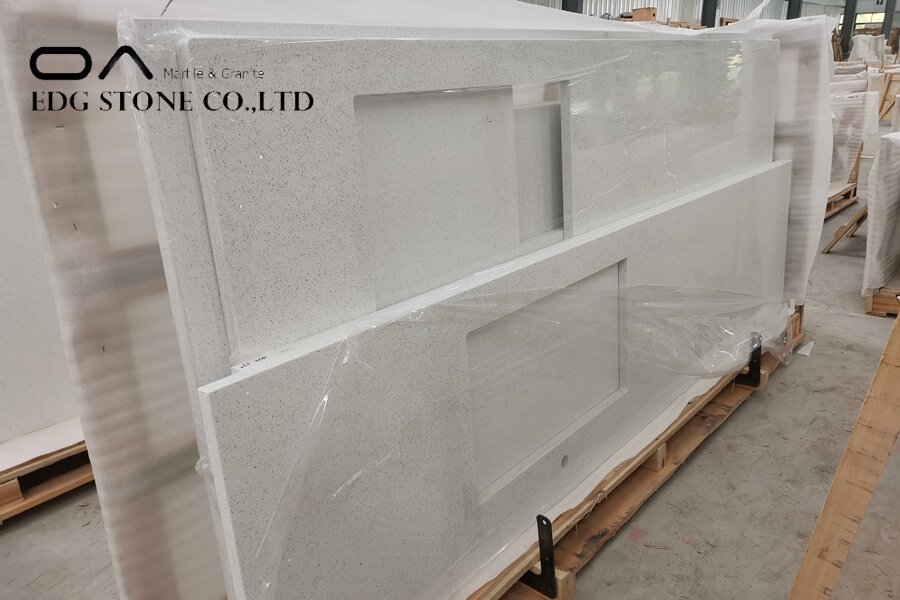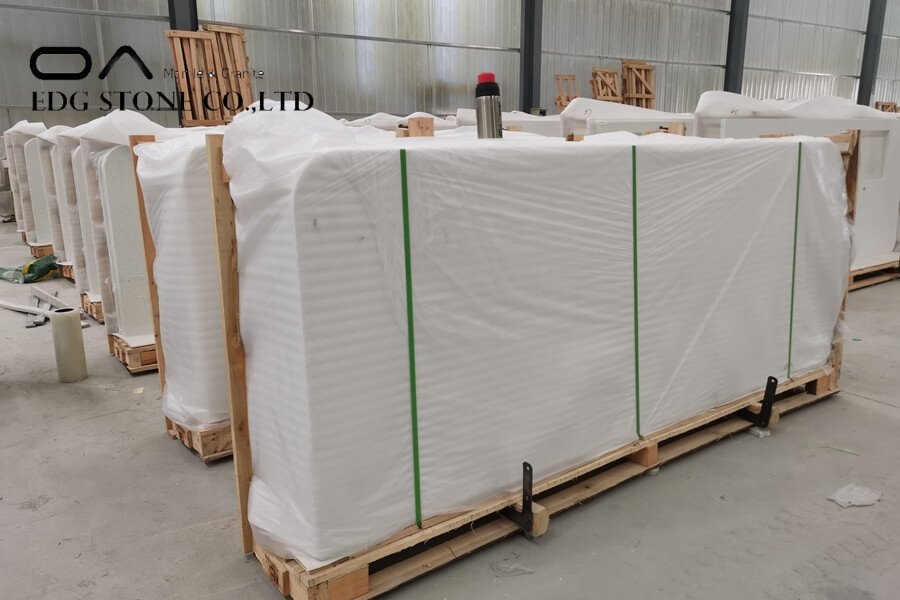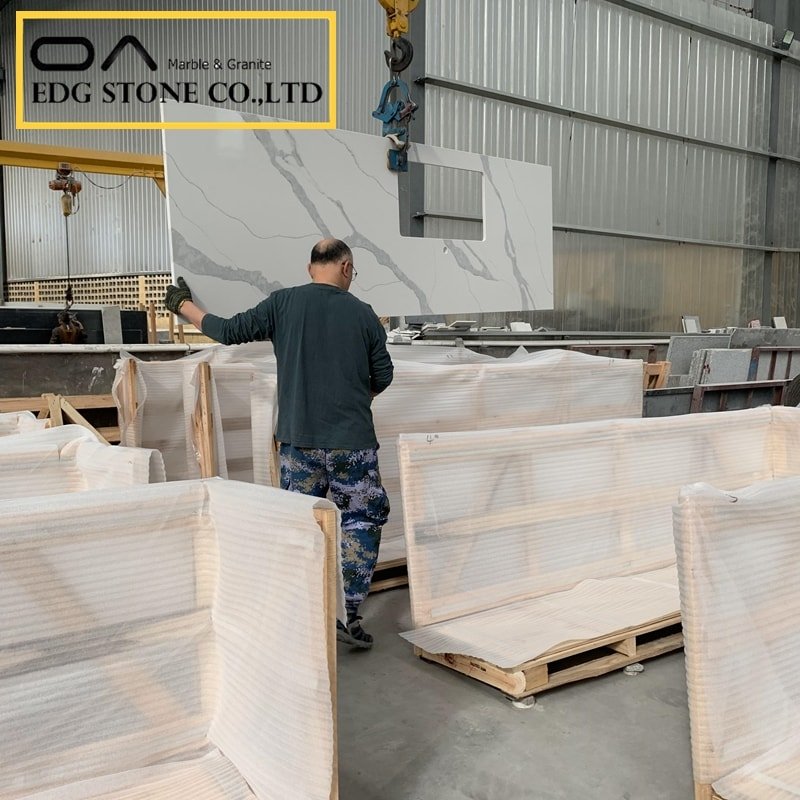1. Overview of Quartz Stone
Quartz stone has entered the Chinese market and is now in a stage of rapid development. However, the current Chinese quartz stone is still in the stage of counterfeiting and imitating quartz stone in a strict sense. The quartz stone produced by most manufacturers is not in the true sense. Quartz stone, the “quartz stone” popular in the market is mainly fake quartz stone. The most obvious phenomenon is the use of glass instead of quartz. Quartz is a crystal, glass is not a crystal, glass is a vitreous substance, and quartz is an atomic crystal. The second is to use granite. The raw materials of granite are adjusted to the color of quartz stone instead of quartz stone. The granite uses calcium carbonate as the filler, which has low hardness and is easy to break. Many other small factories adopt manual pouring. The production equipment and technology are based on the production of ordinary artificial stone with slight improvements. They produced fake quartz stone has the shortcomings of easy deformation, poor hardness, easy color bleeding, and many bubbles. These problems do not exist when pressed by high pressure.
At present, the development direction of quartz stone products is mainly in kitchen countertops, bathroom countertops, bar counters, coffee tables, floors, and interior and exterior walls, etc., and will gradually replace the natural stone, high-grade ceramics, wood, and metal decorative materials. At the same time, the proportion of quartz stone application is constantly changing. Quartz stone in the kitchen cabinet industry is becoming a new substitute product, and the proportion of floor stone decoration is increasing substantially. Because the hardness of quartz stone is very large, reaching 5-7 on the Mohs, this brings certain difficulties to the processing technology of quartz stone. The consumption of whole cabinets is becoming more and more individualized, which puts forward higher requirements for the processing of cabinet countertops. The splicing and modeling technology of quartz stone is very high, and it will leave flaws if you don’t pay attention to it. The hardness of quartz stone also has higher requirements for the splicing of quartz stone.
2. Definition and composition of quartz stone
(1) Quartz stone is a new type of stone formed by 90% quartz sand powder and 10% resin under high pressure under vacuum and shaped under high temperature. It is non-radioactive pollution, reusable environmental protection, green new building materials, and decorative materials. Its main body is quartz sand powder, which accounts for about 90%, and resin, pigments, and other auxiliary materials account for about 10%. Quartz stone must fully meet the following four conditions, even if one of the conditions is not met, it belongs to fake quartz stone.
1. Resin content (including all liquid auxiliary materials) 7-12%. Less than 7% has insufficient toughness and is easy to break; higher than 12% is easy to deform. The resin content of many domestic manufacturers is about 15%, so it is fake quartz.
2. It must be formed under high pressure under a vacuum. Low-pressure forming or pouring forming, the compactness of the quartz stone plate is insufficient, easy to bleed, and not stain resistant. Many domestic manufacturers are mainly low-pressure forming, so it is fake quartz.
3. It is solidified and shaped under high temperatures. Many domestic manufacturers are mainly cold-curing or low-temperature curing below 100 ℃, so it is fake quartz stone.
4. The hardness of the quartz stone plate must be provided by quartz sand. Glass is not quartz, and the proportion (mass percentage) of glass particles in the quartz stone plate must be less than 20%.
(2) Resin: Resin is the basic material for quartz stone, which acts as a bonding agent in the quartz stone plate and provides toughness to the quartz stone plate. There are two main resins used in quartz stone: one is unsaturated polyester resin, and the other is acrylic resin (acrylic resin). However, 100% of domestic manufacturers use unsaturated polyester resin, and acrylic quartz stone has not been reported in China.
1. Unsaturated polyester resin—-different formulas are determined according to different requirements; different formulas have different resin properties. The resins on the market are general-purpose resins. Unless you have special requirements and engineers have a good understanding of resin.
2. General classification of unsaturated polyester resin:
From the saturated dibasic acid points: o-phthalic resin and iso-phenyl resin. 100% of general-purpose resins are o-phthalic resins, so-called iso-phenyl resins may not be 100% free of o-phthalic resins, and heat-resistant resins are mostly iso-phenyl resins.
Divided from glycol: general resin and special resin. General-purpose resins are propylene glycol, ethylene glycol, and diethylene glycol, or one or two of them are produced by the reaction of o-benzene; special resins are more complex alcohols, such as neopentyl glycol.
Divided from monomer: general-purpose resin—100% monomer is made of styrene; special resin—complex. The so-called composite acrylic resin on the market is a general-purpose resin with less than 10% methyl methacrylate (MMA) added to replace part of the styrene. It is not acrylic.
3. Acrylic resin (acrylic resin)—resin such as plexiglass. Only use quartz stones with special requirements. Acrylic resins are divided into two types from the perspective of manufacturing: dissolved acrylic resins and prepolymerized acrylic resins. Generally speaking, the prepolymer type is better than the dissolved type.
(3) Filling material: The main component of the quartz stone filling material is silica, including quartz stone sand, quartz stone powder, foundry sand, broken glass, shells, and sea sand. Its main functions are as follows: one is to fill the volume; the second is to enhance the texture of the quartz stone; the third is to enhance the mechanical properties of the quartz stone; the fourth is to act as a flame retardant.
(4) Pigments: The role of pigments in quartz stone is to adjust the variety of colors to make the colors rich and colorful. In theory, any color can be formulated through various types of pigments.
(5) Curing agent: Curing agent is an indispensable auxiliary for the production of quartz stone, and good quartz stone is formed by high-temperature curing.
(6) Other additives: The resin is a polymer material. Appropriate addition of some additives can improve its process performance, increase production efficiency, improve the performance of quartz stone, and prolong its life.
3. Quartz stone production process
Raw material inspection — pre-mixed — color paste (weigh according to the formula) — agitating (first coarse particles, then fine particles) — cloth — stamping (20T-50T) vacuum/vibration ( 24 2000W vibrators)———baking (80 degrees and more than 2 hours)————cold curing (48 hours)————the fixed thickness (1.5-2MM)————polishing (1MM)———— Grading-waxing-filming-warehousing
4. The performance of quartz stone
Quartz stone is higher in hardness, rigidity, and weight than natural marble and ordinary artificial stone. It has strong wear resistance, bright and diverse colors, and can be mixed with multiple colors. Its performance is mainly manifested in:
(1) Scratching: The content of quartz is as high as 93%. Quartz crystal is a natural mineral whose hardness is second only to diamond in nature. Its surface hardness can be as high as 7 on the Mohs scale. Will be scratched by it.
(2) No pollution: Quartz stone is a dense and non-porous composite material manufactured under vacuum conditions. Its quartz surface has excellent corrosion resistance to kitchen acid and alkali, and liquid substances used in daily use will not penetrate. Inside, the liquid that is placed on the surface for a long time only needs to be wiped off with a rag with clean water or a cleaning agent such as Jierliang, and the remaining material on the surface can be scraped off with a blade if necessary.
(3) Durable: The shiny and bright surface has undergone more than 30 complicated polishing treatments, which will not be scratched by a knife or shovel, will not penetrate into liquid substances, will not cause yellowing and discoloration, etc., daily cleaning Just rinse with clean water, simple and easy. Even after a long period of use, its surface is as bright as a newly installed countertop, without maintenance and maintenance.
(4) Incombustible: Natural quartz crystal is a typical refractory material, its melting point is as high as 1300 degrees, and the quartz stone made of 93% natural quartz is completely flame retardant and will not burn due to exposure to high temperatures. It also has an artificial stone, etc. Unmatched high-temperature resistance characteristics of the countertop.
(5) Non-toxic and non-radiation: The surface of the quartz stone is smooth, flat and no scratches are retained. The dense and non-porous material structure makes bacteria nowhere to hide. The material has passed the US NSF certification and can be directly contacted with food. It is completely non-toxic No radiation, non-toxic, and environmentally friendly.
(6) Rich colors: Through the careful preparation of toner, all possible colors can be deployed.
5. Quartz stone application field
(1) Countertop
1. Ordinary countertops: cabinet countertops, bathroom vanity countertops, window sills, dining tables, commercial counters, reception counters, writing desks, computer tables, bar counters, coffee tables, etc.
2. Hospital countertops and laboratory countertops: artificial stone has excellent acid and alkali resistance, is easy to clean and take care of, and there is no place for bacteria to hide, meeting the requirements of a sterile environment.
(2) Ground
1. Floor tiles (both indoors and outdoors)
2. Ground parquet
(3) Wall
1. Wall tiles (indoor and outdoor requirements are higher)
2. TV background wall
(4) Commercial decoration
1. Architectural decoration
2. Decoration of entertainment venues
(5) Furniture application
(6) Bathroom application
(7) Art processing
6. The main specifications of quartz stone
The plates are formed according to two standard sizes of length×width×thickness (unit: mm):
Type A: 2440×760×12-30 (±0.3)
Type B: 3200×16000×12-30 (±0.3)
7. Maintenance and maintenance of quartz stone
Although quartz stone as a professional countertop material has comprehensive advantages that other materials cannot match, any index is relative. No material can withstand destructive use. When using it, pay attention to the following matters and try to protect your Valuable countertop, avoid damage to the countertop due to improper use.
1. Sharp objects may cause damage to the surface and the material itself
Quartz stone is a high-hardness composite material with high impact resistance and scratch resistance, and will not be scratched or worn under normal use. If there are rubber, nail polish, paint, and other sticky substances that are particularly difficult to remove, if necessary, use a knife to gently scrape off. When scraping, you need to control the strength to avoid damaging the table. In particular, avoid using ultra-high hardness sharp tools to forcefully scratch the table surface, such as diamonds, sandpaper, broken glass, broken ceramics (including sintered particles that may exist at the bottom of inferior ceramic vessels), high-hardness alloy knives, and hand tools.
2. Local overheating will cause damage to the surface and internal materials of the countertop at high temperatures.
The surface of quartz stone has good heat resistance, and it is generally not burned by high temperature, scorched, deformed, and dented. However, materials have the characteristics of thermal expansion and contraction. Heat changes can change the internal structure of the material. Long-term overheating will cause accidental damage to the material, and cause local expansion of the countertop, resulting in cracking of the countertop. Therefore, during use, avoid local overheating of the countertop, avoid grilling the countertop with an open flame, and avoid placing high-calorie utensils (such as hot pots, hot water utensils, etc.) directly on the countertop. It is recommended to use pot pads with good heat insulation, or Use pot pads that allow the heat to dissipate to protect your countertop.
3. The impact of heavy objects will damage the countertop
Although the quartz stone contains a composite material that improves the toughness of the material, the thickness of the plate is as high as 15mm, and it has relatively high impact resistance, but it is still necessary to avoid hitting the tabletop, frequent hitting the tabletop or pressing the suspended part of the tabletop with gravity, especially Weak parts on the countertop, such as near the stove, near the water basin, corners, splicing parts, middle parts of the large-span cabinet, etc., otherwise the countertop will be cracked or damaged.
4. Long-term strong ultraviolet irradiation will affect the surface gloss of the quartz stone countertops, and local irradiation may leave chromatic aberrations.
5. If the density of the cleaning agent used on the countertop is too high, please use water for the final cleaning. If necessary, you can use a knife to scrape away the remaining material on the surface.









